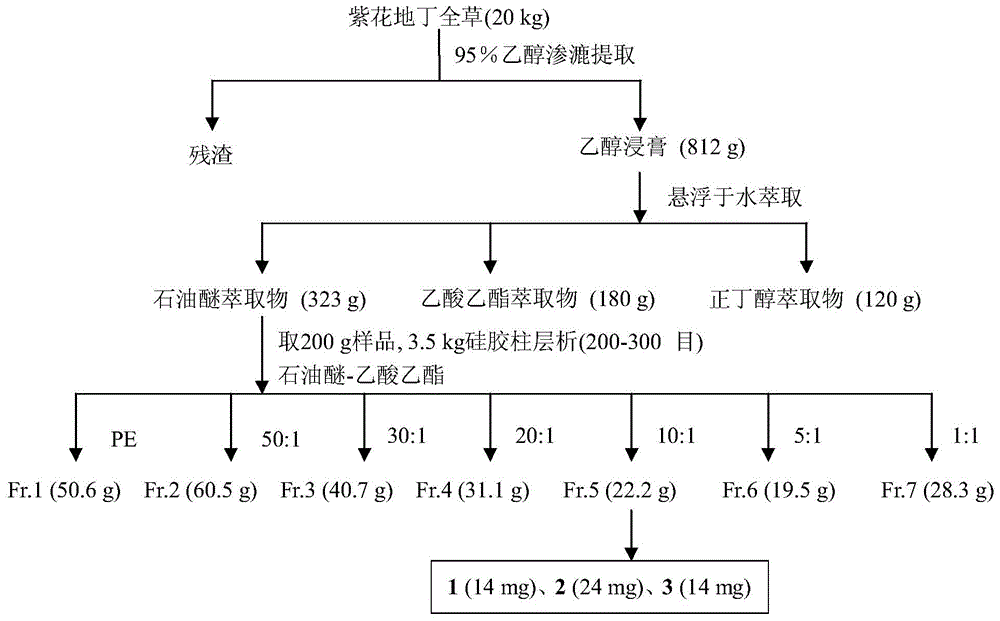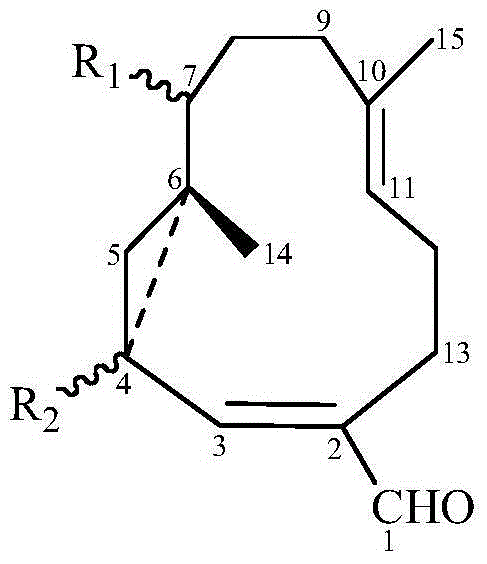Uses of macrocyclic germacrane sesquiterpenoids in preparation of anticomplementary drugs
A technology of macrocyclic gemmane and sesquiterpenoids, which is applied in the field of traditional Chinese medicine and pharmaceuticals, and can solve the problems that macrocyclic gemmane-type sesquiterpenoids have not yet been discovered.
- Summary
- Abstract
- Description
- Claims
- Application Information
AI Technical Summary
Problems solved by technology
Method used
Image
Examples
Embodiment 1
[0025] Example 1. Preparation of macrocyclic guimarane-type sesquiterpenoids
[0026] Take 20kg of dried Viola sibiricum whole plant, crush it, and extract with 95% ethanol at room temperature cold soaking (50L×5 times), combine the extracts and concentrate until there is no alcohol smell, dilute the extract with water to 2.5L, and then use equal volume of petroleum Extract with ether (60-90°C), ethyl acetate, and n-butanol (2.5L×3 times each), combine the petroleum ether extracts and concentrate to dryness to obtain 323 g of petroleum ether extract. The extraction fraction of petroleum ether (200g) was separated by silica gel column chromatography, followed by a gradient of petroleum ether-ethyl acetate (petroleum ether, 50:1, 30:1, 20:1, 10:1, 5:1, 1:1) After elution, 7 fractions (Fr.AG) were obtained, of which fraction Fr.E (22.2g) was subjected to silica gel column chromatography (petroleum ether-ethyl acetate as eluent, 30:1, 20:1, 15 :1,10:1,5:1) and SephadexLH-20 (chlorof...
Embodiment 2
[0027] Example 2. In vitro anti-complement classic pathway test
[0028] Take 0.1ml of complement (guinea pig serum), add barbital buffer (BBS) to make a 1:5 solution, and use BBS to dilute to 1:10, 1:20, 1:40, 1:80, 1: 160, 1:320 and 1:640 solutions. Dissolve 0.1ml each of 1:1000 hemolysin, each concentration of complement and 2% sheep red blood cells (SRBC) in 0.3ml BBS, mix well, put it in a low-temperature high-speed centrifuge after 30 minutes in a 37°C water bath, and centrifuge at 5000rpm and 4°C 10min. Take 0.2ml of the supernatant from each tube to a 96-well plate, and measure the absorbance at 405nm. The experiment also set up a complete hemolysis group (0.1ml 2% SRBC dissolved in 0.5ml tri-distilled water). The absorbance of the three-distilled water-soluble blood vessel was used as the standard for total hemolysis to calculate the hemolysis rate. Taking complement dilution as the X axis, the percentage of hemolysis caused by each dilution of complement is plotted ...
Embodiment 3
[0029] Example 3. In vitro anti-complement alternative pathway test
[0030] Take 0.2ml of complement (human serum), add AP to dilute (barbital buffer, pH=7.4, containing 5mMMg 2+ , 8mMEGTA) solution was prepared into a 1:5 solution, and double-diluted into 1:10, 1:20, 1:40, 1:80, 1:160, 1:320 and 1:640 solutions. Take 0.15ml of complement of each concentration, 0.15ml of AP diluent and 0.20ml of 0.5% rabbit red blood cells (RE), mix well, place in a low-temperature high-speed centrifuge after 30min in 37℃ water bath, and centrifuge at 5000rpm and 4℃ for 10min. Take 0.2ml of the supernatant from each tube to a 96-well plate, and measure the absorbance at 405nm. The experiment also set up a complete hemolysis group (0.20ml 0.5% RE dissolved in 0.3ml triple distilled water). The absorbance of the three-distilled water-soluble blood vessel was used as the standard for total hemolysis to calculate the hemolysis rate. Taking complement dilution as the X axis, the percentage of hemol...
PUM
 Login to View More
Login to View More Abstract
Description
Claims
Application Information
 Login to View More
Login to View More - R&D
- Intellectual Property
- Life Sciences
- Materials
- Tech Scout
- Unparalleled Data Quality
- Higher Quality Content
- 60% Fewer Hallucinations
Browse by: Latest US Patents, China's latest patents, Technical Efficacy Thesaurus, Application Domain, Technology Topic, Popular Technical Reports.
© 2025 PatSnap. All rights reserved.Legal|Privacy policy|Modern Slavery Act Transparency Statement|Sitemap|About US| Contact US: help@patsnap.com



